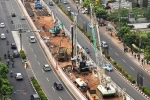Buffer zone of capital city: Tackling the development of Depok
Penyangga Ibu Kota: Menyiasati perkembangan Depok
Bisnis Indonesia, 27 April, 2017
By Yanita Petriella
Depok, as one of the Capital City’s satellite towns, has encountered rapid development.
Of course, Depok is also one of the targets for housing settlement of workers in the Jakarta area.
To the west, Depok City is bordered by South Tangerang, in the south by Bogor, to the east by Bogor and Bekasi, and in the north by Special Capital Territory of Jakarta (DKI Jakarta).
Head of Toll Road Regulatory Agency, Herry Trisaputra Zuna, said that the construction of road network system in Jabodetabek [Jakarta, Bogor, Depok, Tangerang, Bekasi], which in fact is a metropolitan area, is being developed by dividing it into four rings and eight radials.
The four rings and eight radials will later become alternative road accesses for the community in Jabodetabek.
The four rings comprise the following: the first ring is the six toll road segments [to be built]. The second ring is the Jakarta Intra Urban toll road, which has been operating.
"The third ring is the Tanjung Priok access road, which has been recently opened. The fourth ring is how to realise [the link] from [Soekarno-Hatta] Airport to the harbour," he said in a discussion on Depok Infrastructure Supporting City Amenities, on Wednesday (26 July).
Meanwhile, the eight radials include the Jakarta - Cikampek Elevated toll road segment, Jagorawi toll road segment, Depok - Antasari toll road segment, which will in due course be built until Bogor and connect to the Bogor Outer Ring Road toll road, and subsequently connect to the Bogor - Ciawi - Sukabumi toll road segment.
"Then, there are the Sepong - Balaraja toll road segment and the Jakarta - Tangerang toll road segment. The city concepts of Jabodetabek are very unbalanced. In the morning and evening, there are dense traffic movements. Like it or not these radials should be added," he said.
Herry targets all of the four toll ring roads to become accessible by 2019.
Of course, with these four rings, vehicles in Jabodetabek will get distributed. Moreover, Depok residents will have easier access and they do not have to go through the Jagorawi toll road, nor the Jakarta Outer Ring Road.
The reason is that the people of Depok have alternative ways through the triangle toll road segments of Depok - Antasari, Cinere - Jagorawi, and Cinere - Serpong.
"With the segment of Airport - Kunciran, presently [the sections of] Kunciran - Serpong, Serpong - Cinere are in the stage of contractor procurement; the Cinere - Jagorawi section is in construction; Cimanggis - Cibitung is in construction; Cibitung - Cilincing will this year begin construction; we are pushing for Depok - Antasari. This year we will push the fourth ring," he said.
Although a number of toll road segments are being constructed to facilitate access to Depok’s city roads, the local government is also involved in building road network and widening the roads.
"The road structure of Depok City in the 80s was not much different from today. Margonda street was like that, inadequate. Probably Depok must add its road network, otherwise the traffic pattern will be just like that; all go through Jalan Margonda," said Herry.
More expensive
Head of the Department of Housing and Settlement of Depok City Government, Wijayanto, denied that Depok City had become a target city for workers who earn a living in the Capital to reside.
"The prices of houses and land in Depok City, when compared to other cities, such as Bekasi, Bogor, and Tangerang, are more expensive," he said.
His office is currently making spatial layout for the next 20 years, which is devoted to economic and socio-cultural interests, as well as sustainability.
"The centre remains at Margonda. The target is that this will be backed up with activity centres in Cimangis, Tapos, Sawangan, Cipayung, and Cinere, so we will equalize public spaces and infrastructure, such as addition to the road network and flood controllers."
The roads in Depok City already have concrete quality, with 31.34 percent being in damaged condition. Public space in Depok has accounted for just 16 percent.
This year, the City of Depok has budgeted Rp 1.1 trillion for infrastructure development, out of the total local government budget (APBD) worth Rp 2.7 trillion.
Depok City Government also has a housing development policy in Depok City, based on the 2000 - 2010 RTRW [Regional Spatial Layout Plan], for it to become a buffer city for the Jabodetabek region.
"We will also reduce the flooding points, [seek to achieve] 100 percent [access to] clean water network, zero percent slum settlement, 100 percent [coverage of] sanitation service, additional drainage, and supply of flats," said Wijayanto.
Meanwhile, Director of Orchid Realty, Mujahid, argues that the development of Depok City has been extraordinary. This is in view of the increase in the population, which reached 2 million people in 2016, compared to the year 2012, which only recorded 1.2 million inhabitants.
The rapid development of Depok City of course also affects the property occupancy rate or property business and demand for vertical residential units is also rising.
Jalan Raya Margonda has become the main commercial centre in Depok City. In the area, the average price of land has touched Rp 20 million per square metre.
"The presence of the University of Indonesia (UI) in Depok City makes Jalan Margonda a business centre," he said.
In the last two to three years, there has been an increased demand for vertical residential units and there are two types of apartments commonly marketed in Depok, namely apartments for students and family dwellings.
"Toll road access to Depok City, the presence of UI, and UI Hospital, have pushed up the demand for vertical housing units and this is very urgent; the land area is small, there are high prices, hence it is not possible to build landed houses," he said.
Demand for student residential units, in fact, is still at the highest level, given the rising number of students who study at the University of Indonesia and the University of Gunadarma.
"There have been changes in student lifestyle, which currently require apartments for residence. The biggest demand is for the studio type, with a price range from Rp 300 million to Rp 500 million," said Mujahid.
Depok City will also have a hospital of the Singapore hospital calibre and it will be the only hospital that can withstand an earthquake of up to 9.8 SR.
Head of University of Indonesia Hospital (RSUI), Julianto Wicaksono, said that construction of the hospital has currently reached 95 percent and next year it will be 100 percent completed.
"The target is for its soft opening to be held in January 2018 and grand opening in July next year," he said in the discussion. [Funding for] the construction of this hospital comes from the Government of Japan, with a loan worth Rp 1 trillion.
Jabodetabek Toll Roads

- Cawang - Soekarno-Hatta Airport
- Procurement Preparation
- Land Acquisition and Construction
- Operational
Source: Ministry of PUPR











